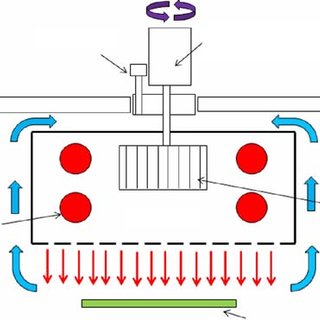Process parameters affecting reflow soldering quality
From: Author:reflow soldering Publish time:2021-09-14 15:10 Clicks:0
Process parameters affecting reflow soldering quality
How does the reflow oven work?
In general, there are four steps in the reflow oven process. The standard reflow profile has four zones: preheat zone, soak zone, reflow zone and cooling zone.
3.1 Working process of the reflow oven
① Preheat zone of the reflow oven
The purpose of this area is to heat the PCB at room temperature as soon as possible to achieve the second specific goal, but the heating rate should be controlled within a proper range.
If it is too fast, it will produce thermal shock, and the circuit board and components may be damaged;
If it is too slow, the solvent volatilization is not sufficient, which will affect the welding quality. Because of the fast heating speed, the temperature difference in the later SMA is large.
In order to prevent the damage of components caused by thermal shock, the maximum speed is generally specified as 4 ℃ / s. However, the rise rate is usually set at 1-3 ℃ / s. The usual heating rate is 2 ℃ / s.
② Soak zone of the reflow oven
Insulation section refers to the area where the temperature rises from 120 ℃ – 150 ℃ to the melting point of solder paste.
The main purpose is to stabilize the temperature of each component in SMA and reduce the temperature difference as much as possible.

Reflow oven heating zone 3D display
Give enough time in this area to make the temperature of larger components catch up with that of smaller components, and ensure that the flux in the solder paste is fully volatilized.
By the end of the insulation section, the oxide on the solder pad, solder ball and element pin is removed, and the temperature of the whole circuit board is balanced.
In the real production, the operator needs to notice that all components on SMA should have the same temperature at the end of this section,
Otherwise, when the board is entering into the re-flux section, there will appear various bad welding phenomena on the board due to the uneven temperature of each part.
③ Reflow zone of the reflow oven
In this zone, the temperature of the heater is set high, which makes the temperature of the component rise rapidly. In the reflow section, the temperature of the welding value varies with the solder paste used.
Generally, it is recommended to add 20-40 ℃ to the melting point of the solder paste. For 63Sn / 37Pb solder paste with a melting point of 183 ℃ and sn62 / pb36 / ag2 solder paste with a melting point of 179 ℃,
The value temperature is generally 210-230 ℃, and the reflow time should not be too long to prevent adverse effects on SMA. The ideal temperature curve is that the area covered by the “end zone” beyond the melting point of solder is small.
④ Cooling zone of the reflow oven
In this zone, the lead-free tin powder in the solder paste has melted and fully wets the connected surface.
Then, the operator should set an appropriate cooling temperature to make it cooled as fast as possible, which will help to obtain bright solder joints and have good shape and low contact angle.
Also, slow cooling will lead to more decomposition of the circuit board into the tin, resulting in dark rough solder joints.
In the case of the end, it can cause poor tin staining and weaken the bonding force of the solder joint. The cooling rate of the cooling section is generally 3-10 ℃ / s, and the cooling temperature is 75 ℃.
In addition, we would like to talk one important element in the reflow oven working course: the reflow oven profile.
So, what is the reflow oven profile?
Actually, it is the soldering temperature curve referring to the point on SMA/SMD changes with time when SMA/SMD passes through reflow oven.
Besides, the temperature curve provides an intuitive method to analyze the temperature change of a component in the whole reflow soldering process.
This is very useful for obtaining the best weldability, avoiding damage to components due to over-temperature, and ensuring the welding quality. The temperature curve is tested by the temperature tester, such as the smt-c20 oven temperature tester.
I.C.T is a manufacturer of SMT machines. It mainly provides customers with SMT production lines including SMT Stencil Printers, Pick and place machines, Reflow Oven, AOI Machine, Wave Soldering Machine and PCB Handling Machine etc. I.C.T has more than 25 researches on SMT and DIP technology, for the world Customers provide SMT total solutions. There are successful cases of SMT technical team in Asia, Europe, America, Africa, and Australia.
I.C.T provide SMT solutions at various stages according to the different needs of customers. I.C.T is not only a provider of SMT equipment and technology, but also is the customer's escort in the field of SMT and DIP.
Welcome more people to discuss with us about SMT technologies and solutions, please contact us for more information:
Tel: +86 13670124230 (WhatsApp/Skype/WeChat)
Email: etasmt@foxmail.com
Keywords:
LED Bulb Assembly Line Semi AutomatIC Machine, LED-Line Assembly-Machine, PCB Solder Paste Printer Semi, Semi AutomatIC Solder Paste Printer, LED Reflow Oven, Thermal Profiler Reflow Oven, Wave Soldering Machine Desktop DIP, Conformal Coating Spray Machine SMT, SMT Roll Wiper Rewinding Machine, SMT Peripherals PCB LED Dispensing Machine, SMT PCBA Pour Machine à Laver, Feeder Rack For SMT Asm Machine, Screening Conveyor SMT, AutomatIC PCB Loader, PCB Screening Conveyor, Screening Conveyor PCB, Conveyor Driver Board, PCB Circuit Boards Separator, Heating PCB Separator For Mobile Ipad

